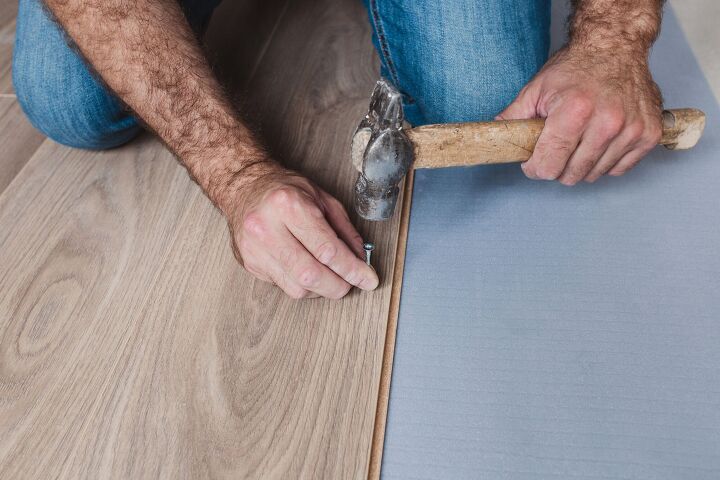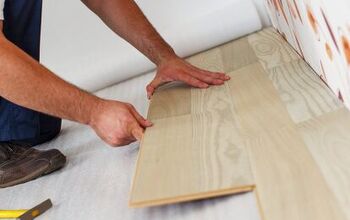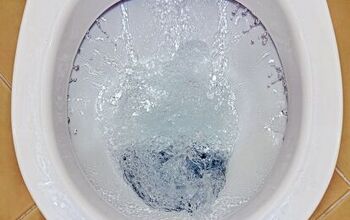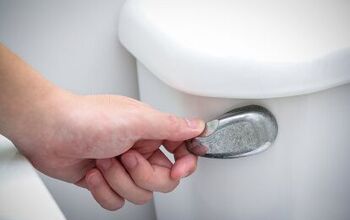Can You Nail Down Laminate Flooring? (Find Out Now!)

For many years, laminate flooring has been one of the most popular alternatives for hardwood used by homeowners. It is designed to mimic real wood, but is more affordable, DIY friendly, relatively easy to clean and maintain, and scratch-resistant than traditional hardwood.
While laminate flooring may look similar to real wood, the installation process is much different. Traditionally, hardwood floors are secured by nailing or gluing them down to the subfloor – which may have you wondering: “Can you nail down laminate flooring?”
Since laminate is specially designed as a floating floor, it should not be nailed down to the subfloor. The flooring will contract and expand naturally in response to changes in humidity, and nailing it down will disturb this process. Nailing down laminate can cause damage to the floor’s integrity and generate a number of issues in the future – including floor peaking.
Both nailing and gluing down laminate flooring is not recommended. Though, the only exception is when you’re installing laminate on stairs, as the boards need to be attached to the steps. Aside from stair installations, the only way to properly install laminate flooring is to lay it out flat over an underlayment on the subfloor – without any nails or adhesives. The key to a successful laminate flooring installation is choosing the right underlayment.
Do You Need Laminate Wood or Stone Flooring Installers?
Get free, zero-commitment quotes from pro contractors near you.

Why You Shouldn’t Nail Laminate Flooring
As previously mentioned, laminate flooring is designed as a floating floor – meaning the floor is installed to literally float above the subfloor or substrate. For this reason, laminate floors should be allowed to move freely. Laminate planks are constructed with a fiberboard core, which gives them their support and stability.
Though, with this fiberboard core, laminate flooring is highly sensitive to moisture and will react to changes in humidity and moisture content in the environment. To adjust to moisture and humidity, the flooring expands and contracts. Because of this, it’s so important to properly acclimate the laminate prior to installation.
The natural contraction and expansion of laminate flooring is the sole reason why an expansion gap exists on the edges. This gap provides enough space for the laminate to move freely as it adjusts to changes in the environment. If you nail down laminate flooring, this doesn’t allow it to expand and contract as needed. Ultimately, this can lead to damages and a decreased lifespan of the flooring. Not to mention, nailing will void the warranty of the laminate product.
Take a look at this if your laminate flooring expansion gap is too big.
Can You Glue Down Laminate Flooring?
In addition to nailing down laminate flooring, you also should not glue the product down in an attempt to secure it. Installing laminate flooring is not the same as installing real hardwood floors. Gluing down the flooring to the subfloor will disrupt the natural contraction and expansion process in the same way that nailing it down would. This type of flooring is simply not designed to be glued or nailed in place.
Though, there are some instances where glue is used, but it’s not for fixing laminate planks to the subfloor. Instead, glue may be implemented to attach planks to one another and enforce the tongue and groove locking system.
This is commonly done in areas that are exposed to water or especially prone to higher levels of moisture. The glue acts as an additional barrier to keep moisture from reaching the floor’s core – thus making the entire surface of your laminate flooring more water-resistant. In normal circumstances though, it is not recommended that you use glue when installing laminate floors.
What Happens if You Nail or Glue Down Laminate Flooring?
Here are some of the problems that can occur if you choose to nail or glue down laminate flooring during the installation process:
Cracking, Splintering & Chipping
Laminate is essentially a pressed board product that is finished with a plastic film to give it the appearance of real wood. However, this finish isn’t solely for looks; it also provides structural support for the underlying board. This board, underneath the plastic, can crack, splitter, and chip when the top coating is pierced – which is why it’s recommended to avoid nailing into the floor once it’s installed.
As the laminate flooring naturally contacts and expands, it will start to chip around the nail holes. As these holes get bigger, minor chipping can travel to other areas of the flooring and eventually have a negative impact on the integrity of the joints and the structural stability of the entire floor.
Peaking
Peaking in laminate flooring occurs when the floorboards press against one another, resulting in pinching and high points in some spots on the floor. Oftentimes, this happens when the laminate flooring was not given a sufficient expansion gap around the perimeter of the room and the edges push against the wall is the floor naturally expands. This may also occur when sections of the floor are fixed to the subfloor, whether it’s via nails, glue, or even screws.
If any part of laminate flooring is secured to the substrate below, as humidity increases and the floor attempts to expand, it will push against the area that is fixed and ultimately lift. Ultimately, this will lead to joint failures or potentially even irreversible warping and buckling of the floor.
Take a look at this if the laminate on your stairs is slippery.
Gapping
Gapping is usually the result of humidity and temperature in the space dropping considerably, forcing laminate flooring planks to pull away at the joints and create unsightly gaps. While this isn’t a very common occurrence, it is certainly a possibility when you nail or glue laminate flooring down to the subfloor. Attached your entire laminate floor, or even just sections, do not allow it to move as a unit and can cause it to separate at the joints when the planks adjust according to the humidity levels in the room.
Do You Need Laminate Wood or Stone Flooring Installers?
Get free, zero-commitment quotes from pro contractors near you.

How to Properly Install Laminate Flooring
The proper way to install laminate flooring is by using the tongue and groove locking system to fasten the planks together. This results in a smooth, seamless floating surface. With that said, follow these steps to properly install laminate flooring in your home:
- Acclimate the flooring. Acclimating your laminate floors first is an essential step to ensure that the product becomes accustomed to the conditions of the space.
- Inspect the subfloor and address imperfections. Laminate floorings must be installed on a flat, smooth subfloor. Dipping, peaking, or other imperfections should be corrected to provide the laminate floor with a level surface to lay on.
- Gather the necessary materials. For the installation, you’re going to need a hammer or rubber mallet, tape measure, tapping-block and pull bar, straight-edge gap spacers, utility knife, table saw or handsaw, and a pencil or marker.
- Clean and prepare the work space. Before the installation, make sure any dust, debris or dirt is cleaned.
- Roll out underlayment. If your laminate flooring has a built-in underpad, you don’t need a separate underlayment. Otherwise, you’ll want to lay down one layer across the subfloor, ensuring that there are no overlapping parts and they meet edge to edge. Tape the pieces down or stick them together.
- Start laying down the laminate planks, based on the layout and direction that you’ve chosen to install them in. For the first row, cut the tongues with a utility knife and install the gap spacers to create a consistent gap between the wall and the planks.
- Continue installing the planks, following the pattern you established and maintaining that gap around the space.
- Install the molding, either shoe or half round, once you’ve finished installing the laminate. This will cover the gap between the wall and the laminate. When nailing this down, make sure you avoid nailing the laminate itself.

Jessica considers herself a home improvement and design enthusiast. She grew up surrounded by constant home improvement projects and owes most of what she knows to helping her dad renovate her childhood home. Being a Los Angeles resident, Jessica spends a lot of her time looking for her next DIY project and sharing her love for home design.
More by Jessica Stone



























